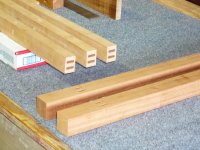Birdhunter
Member
- Joined
- Jun 16, 2012
- Messages
- 4,145
I'm joining a 1/4 to a cross member made of 2 1X4s glued together. So, it is an "L" 90 degree joint that I want to make using 4 tenons.
I did the first set of tenons down 15mm from the top of the two boards and got a perfect joint.
I did the second set of tenons down 30mm from the top and that set was off by a couple of mm.
Is there a trick to doing double sets of tenons? Is there a video showing how to do it?
I did the first set of tenons down 15mm from the top of the two boards and got a perfect joint.
I did the second set of tenons down 30mm from the top and that set was off by a couple of mm.
Is there a trick to doing double sets of tenons? Is there a video showing how to do it?

